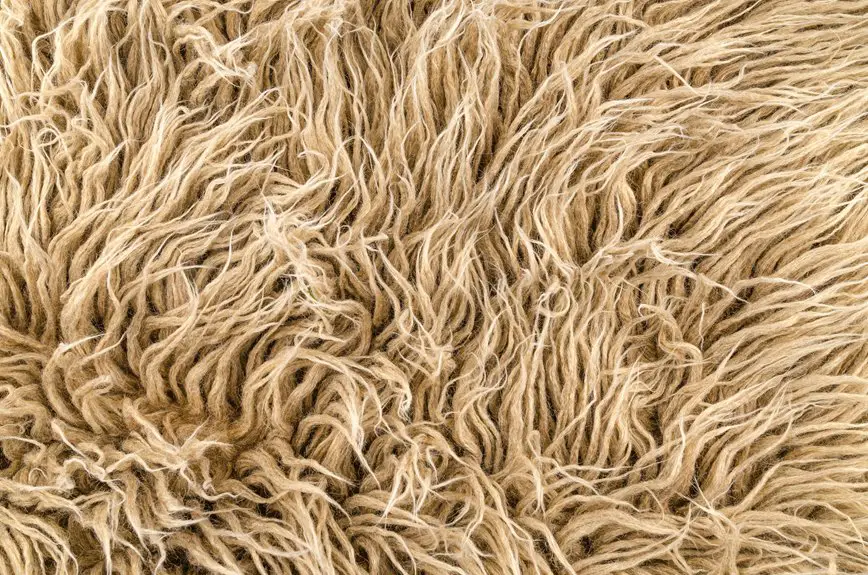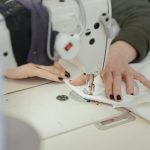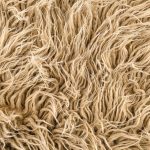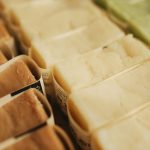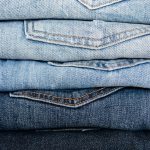You can consider felt a true nonwoven fabric because its fibers bond without weaving or knitting. Instead, they mat together using heat, moisture, and pressure, creating a dense, durable material with uniform strength. Unlike woven textiles, felt’s fibers interlock randomly, giving it unique flexibility and insulation properties. This method aligns with how nonwovens are defined—fibers bonded mechanically or thermally rather than spun into yarn. Keep exploring to uncover how felt’s structure and production set it apart in practical uses.
Table of Contents
Key Takeaways
- Felt is a nonwoven fabric made by matting and compressing fibers without weaving or knitting.
- Fibers in felt bond through heat, moisture, and pressure, creating a dense, interlocked structure.
- Felt’s fiber bonding is mechanical and thermal, qualifying it as a true nonwoven material.
- Unlike woven fabrics, felt has random fiber orientation and no yarns or threads.
- Felt shares key nonwoven properties like durability, flexibility, and porosity, confirming its classification.
Historical Background and Origins of Felt
Felt has a rich history that dates back thousands of years, making it one of the oldest known textiles. When you look at its origins, you’ll find that ancient civilizations like the Mesopotamians and Mongols used felt for clothing, shelter, and insulation.
You might be surprised to learn that felt was even found in Ötzi the Iceman’s belongings, dating back over 5,000 years. The process of making felt—matting and compressing fibers—allowed early cultures to create durable, warm materials without weaving.
If you explore traditional crafts today, you’ll see that felt-making remains largely unchanged, highlighting its timeless practicality. Understanding felt’s historical roots helps you appreciate how it evolved as an essential material long before modern textile technology emerged.
Defining Nonwoven Fabrics: Key Characteristics
You’ll want to understand how fibers bond to form nonwoven fabrics, whether through mechanical, chemical, or thermal methods.
Pay attention to the structural properties that set these fabrics apart, like strength, flexibility, and porosity.
These characteristics help define what makes a fabric truly nonwoven.
Fiber Bonding Methods
Although you mightn’t realize it, the way fibers bond together plays an essential role in defining nonwoven fabrics. Unlike woven or knitted textiles, nonwovens rely on specific bonding methods to create a cohesive material without interlacing yarns.
When you examine felt, understanding these bonding techniques helps you see why it qualifies as a nonwoven fabric.
Here are common fiber bonding methods:
- Mechanical entanglement: Fibers are physically tangled, like in needle-punched or spunbond felts.
- Thermal bonding: Heat fuses thermoplastic fibers together.
- Chemical bonding: Adhesives or binders hold fibers in place.
- Hydroentanglement: High-pressure water jets interlace fibers.
Recognizing these methods clarifies felt’s classification and highlights the diversity within nonwoven fabric production.
Structural Properties Criteria
Understanding how fibers bond sets the stage for recognizing the structural properties that define nonwoven fabrics.
When you examine felt, you’ll see it lacks the woven or knitted structure seen in traditional textiles. Instead, its fibers interlock through mechanical, chemical, or thermal processes, creating a dense, cohesive web.
You’ll notice nonwoven fabrics typically have uniform thickness, strength, and porosity, all influenced by fiber orientation and bonding method.
Felt meets these criteria because its fibers form a tangled mat without yarns, giving it consistent density and durability.
So, when you assess structural properties like fiber arrangement, bonding strength, and fabric uniformity, felt fits squarely within the nonwoven fabric category.
This clarity helps you understand felt’s unique place in textile classification.
The Structure and Composition of Felt
Many people recognize felt by its unique texture, but its structure and composition reveal why it stands apart from other fabrics.
Felt is a dense, nonwoven material made by matting fibers together without weaving or knitting. When you examine felt, you’ll notice these key characteristics:
- Fibers are interlocked through heat, moisture, and pressure, creating a compact web.
- It often contains natural fibers like wool, which have microscopic scales aiding adhesion.
- The random fiber orientation gives felt uniform thickness and strength.
- No yarns or threads are involved, distinguishing felt from woven or knitted fabrics.
Understanding these points helps you appreciate felt’s distinct makeup, which plays a significant role in its classification as a nonwoven fabric.
Manufacturing Processes of Felt Compared to Nonwovens
Now that you know how felt’s fibers bond to form its dense, uniform structure, it’s helpful to compare how felt is made versus other nonwoven fabrics.
Understanding felt’s fiber bonding offers insight into its unique dense, uniform structure compared to other nonwoven fabrics.
When you make felt, you primarily rely on matting, condensing, and pressing fibers together using moisture, heat, and pressure. This traditional process transforms loose wool or synthetic fibers into a cohesive fabric without weaving or knitting.
In contrast, most nonwoven fabrics are produced through methods like spunbonding, meltblowing, or needle punching, which mechanically or chemically bond fibers in web form.
These processes often use thermoplastic fibers and can be continuous and highly automated. So, while felt’s production is more manual and relies on fiber interlocking, nonwoven manufacturing typically emphasizes synthetic fiber bonding and rapid production techniques.
Fiber Bonding Mechanisms in Felt
You’ll notice that felt’s strength comes from fibers mechanically interlocking rather than weaving or knitting.
Moisture and heat play an essential role by helping the fibers bind tightly together during the felting process.
Understanding these bonding mechanisms helps clarify why felt behaves differently from other fabrics.
Mechanical Fiber Interlocking
Mechanical fiber interlocking forms the backbone of felt’s unique structure. When you examine felt, you’ll notice its fibers aren’t just loosely gathered—they physically entangle and lock together. This interlocking happens as fibers overlap, twist, and push against each other, creating a dense and cohesive fabric without weaving or knitting.
Here’s what you should know about mechanical fiber interlocking in felt:
- Fibers have scales or barbs that catch onto neighboring fibers.
- The random orientation enhances entanglement.
- Pressure and agitation during manufacturing tighten the mesh.
- Interlocked fibers resist pulling apart, giving felt strength.
Understanding this helps you see why felt holds together so firmly, confirming its identity as a nonwoven fabric based on mechanical bonding rather than traditional textile methods.
Role of Moisture and Heat
Although fiber interlocking plays a major role, moisture and heat actively work together to bond fibers in felt during production.
When you apply steam or hot water, the moisture swells the fibers, making their scales lift and interlock more easily. Heat then softens the fibers, allowing them to mold and lock into place as they cool. This combination strengthens the felt’s structure beyond mere mechanical entanglement.
Without moisture and heat, fibers wouldn’t bond as firmly, resulting in a weaker, less durable fabric.
Applications and Performance of Felt as a Nonwoven Material
Because felt combines durability with flexibility, it finds diverse applications across industries. When you choose felt, you benefit from its excellent cushioning, insulation, and sound absorption properties.
Its performance as a nonwoven material makes it ideal for various uses, including:
- Protective padding in automotive and machinery parts
- Acoustic panels for noise reduction in buildings
- Insulation layers in appliances and HVAC systems
- Crafting and fashion accessories requiring moldability
You’ll notice felt’s ability to resist wear and maintain shape under pressure enhances product longevity.
Plus, its moisture resistance and thermal stability improve function in challenging environments. Understanding these performance traits helps you appreciate why felt remains a popular, reliable choice when durability and adaptability are key.
Frequently Asked Questions
Can Felt Be Recycled Like Other Nonwoven Fabrics?
You can recycle felt, but it depends on its fiber content. Natural fiber felts recycle easier than synthetic ones. Check local recycling guidelines, since some facilities may not accept certain felt types or blends.
How Does Felt’s Environmental Impact Compare to Woven Fabrics?
Imagine felt as a cozy sweater versus woven fabric’s structured jacket. Felt generally uses less energy and water to produce, so when you choose it, you’re wrapping yourself in a greener, more eco-friendly option.
What Are the Common Defects Found in Felt Production?
You’ll often see defects like uneven thickness, weak spots, holes, or contamination in felt production. These flaws happen due to poor fiber distribution, inadequate bonding, or impurities, so you need careful quality control throughout the process.
Is Felt Suitable for Medical or Hygiene Applications?
You’ll find that 70% of nonwoven medical products use materials like felt for filtration and padding. Felt’s absorbency and softness make it suitable for hygiene applications, but you must guarantee it meets strict sterilization standards.
How Does Felt’s Cost Compare to Synthetic Nonwoven Fabrics?
You’ll find felt generally costs less than synthetic nonwoven fabrics because it’s made from natural fibers and simpler processes. However, pricing varies based on quality, thickness, and production scale, so always compare specific products before deciding.
- How Is Nonwoven Fabric Made Differently Than Woven Fabric? - July 11, 2025
- Decoding Nonwoven Fabric: From PP to PET and Beyond - July 11, 2025
- The Essential Guide to Woven vs. Nonwoven Textiles - July 11, 2025

